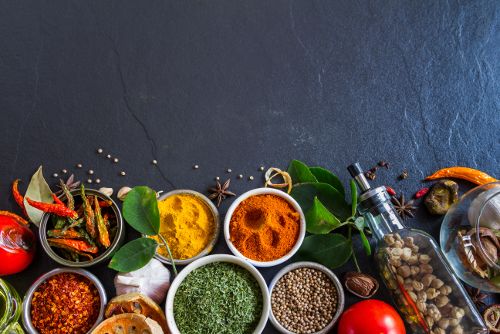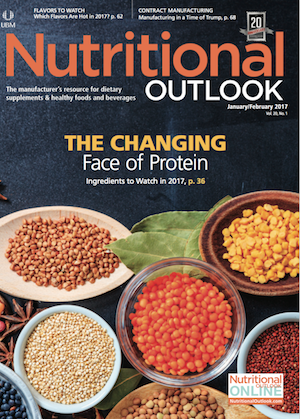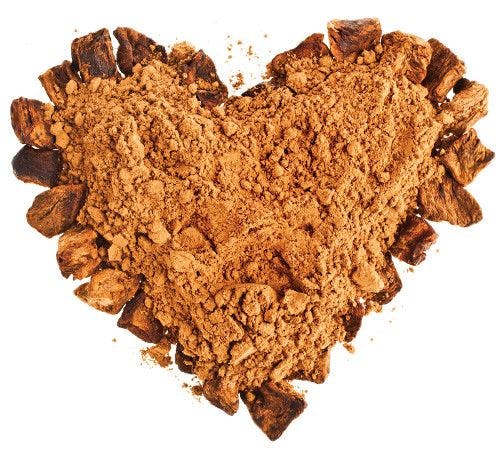2017 Flavor Trends for Food and Beverage
Experts predict 2017’s hottest flavors.
Photo © Shutterstock.com/joker1991

It’s that time of year again when Nutritional Outlook asks flavor houses and experts to predict which flavors will most appeal to consumers in the coming year. Experts agree that in 2017, consumers will share a desire for natural flavors, both those familiar and those more unusual. As beverage-development firm Flavorman (Louisville, KY) says: “The flavor forecast for 2017 is shaping up to be all about seeking healthy and clean oldies-but-goodies [as well as] a bit of the exotic.”
Spice It Up
Above all, experts interviewed for this story agree on one thing: spicy flavors are hot. In a press release, Comax Flavors (Melville, NY) cites Technavio market research reports that the U.S. spices and seasonings market is forecasted to grow at a CAGR of 6.72% during 2016–2020. “Driven by globalization and the growing multicultural population, spices that were once exotic and unfamiliar are becoming familiar and ubiquitous,” says Comax. “Spices are now mainstream and accessible.”
Greg Kaminski, corporate research chef for Synergy Flavors (Wauconda, IL), highlights the spice cardamom in particular. “While ginger has dominated in recent years, cardamom is the epitome of a true, universal flavor, growing 300% in U.S. product launches in the last five years,” Kaminski says, citing Mintel research.
Cardamom spans the globe in everything from Scandinavian sweets and Indian curries/sauces to coffee in the Middle East. “Thanks to its versatility and complexity, cardamom pairs well with both sweet and savory dishes, and enhances various other profiles,” says Kaminski. Formulators can get creative with cardamom. Kaminski offers just a few examples: a cardamom-and-grilled-pineapple protein drink; cardamom, orange, and cinnamon taffy; and a cardamom, coconut, and ginger Indian curry shortbread cookie.
Other curry spices are hot, as well. In addition to cardamom, Kaminski points to tamarind, lemongrass, ginger, kaffir lime, cinnamon, and clove.
Beverage developer Flavorman points to the growing use of spicy flavors in beverages. “Hot and spicy flavors have risen in popularity in beverages over recent years due in part to the ongoing interest and exploration of ethnic cuisines across the United States,” the company said in a press release. That includes alcohol, said Flavorman, adding that major distillers are extending their lines with “spicy versions of rum, bourbon, and whiskey.”
Comax Flavors offers its Spice Is Nice collection, which includes such flavors as cinnamon caramel, cocoa curry, and ginger mandarin cardamom, for everything from coffee and tea to dairy and alcohol. “Consumers are now open and willing to experiment with spices to experience new flavors,” said Catherine Armstrong, Comax Flavors’ vice president of corporate communications, in a press release.
Turmeric's reputation continues to grow, not only as a spice but as a healthful ingredient. Flavorman ranks turmeric as “the top trending flavor for 2017,” noting that it is now found in “teas such as cold- and flu-fighting apple green tea and cleansing smoothies like carrot, beet, and turmeric.”
Megan Trent, marketing representative for Gold Coast Ingredients (Commerce, CA), pegs some of 2017’s hottest spices as sriracha, jalapeño, chipotle, ghost pepper, and harissa. She says nutraceutical makers are turning to spices as a way to add excitement to their products. “In 2016, spicy (heat) flavors innovated the nutraceutical industry,” such as in sweet and savory nutrition bars. “We predict more experimentation in 2017 as companies find new and exciting ways to add heat to their products,” Trent says.
Spices have the added benefit of appealing to younger consumers, points out flavor supplier Kerry (Beloit, WI). “Indian, Thai, Japanese, Filipino, and Korean flavors are particularly favored by younger generations,” the firm says, especially Asian spices and flavors like cardamom, togarashi, dragon fruit, yuzu, shiitake mushroom, chutney, szechuan, miso, maitake mushroom, shishito pepper, turmeric, and gochujang. “Look forward to these spices popping up on non-traditional items such as chips and fries, which creates an approachable dish for consumers to try these spicy and unique flavors,” the company says.
Florals, Fruits, and Veggies
Floral and fruity notes are also becoming more popular with consumers, experts say. “In 2015 and 2016, there was an increase in products with sweet (fruity, honey) and subtle floral flavor notes,” says Gold Coast’s Trent.
Flavor supplier Virginia Dare (Brooklyn, NY) predicts that tropical fruit flavors will fare well. “Professional chefs expect Hawaii-inspired cuisine, like poke, to be a top-growing trend. In 2017, we predict that the most popular new fruit flavors will also be tropical, like jackfruit, lychee, and new varieties of mango,” says Bob Verdi, PhD, business director of health and wellness, Virginia Dare. “These fun and delicious flavors are new to many consumers.”
In addition, although coconut has been popular for several years now, demand isn't waning, says Flavorman, who says the company expects to see more interest in coconut in 2017.
One of the trendiest fruits in 2017 could be cucumber, numerous experts predict. Firmenich (Geneva, Switzerland), for instance, has named cucumber the company’s “2017 Flavor of the Year.” According to a Firmenich press release, “At first glance, the cucumber may appear to be just a simple salad staple, yet it is gaining traction around the world, with a 392% increase in the use of cucumber as a flavor globally between 2011 and 2016” according to Mintel. “In recent years, cucumber has appeared everywhere from potato chips and confection to yogurt and dumplings,” Firmenich notes. The company says consumers are drawn to cucumber’s “lighter, refreshing ‘green’ flavor”; the soothing, nourishing refreshment it provides “in a busy, stressful world”; and the fact that cucumber is clean and healthy.
STORY CONTINUES ON PAGE 2
Market researcher SPINS (Chicago) also calls out the cucumber trend, noting that “we expect to see cucumber in more craft sodas, flavored waters, and other refreshment beverages, gaining traction in the grab-n-go section.”
Floral flavors are also on point these days, say many firms. “Traditionally [the] U.S. seldom ingests flowers or floral flavors compared to other countries. However, floral flavors are popping up and making their way into food and beverages, including alcoholic and non-alcoholic beverages and dairy products such as yogurt and ice cream,” says Comax Flavors. The company's Flower Power line includes blueberry hibiscus, orange blossom vanilla, and raspberry lavender. Flavorman also encourages the use of “herbal accent flavors.”
Virginia Dare’s Verdi observes that ready-to-drink products like packaged waters are increasingly featuring floral notes-everything from lavender and strawberry blossom to hibiscus, iris, rosehip, and cherry blossom. “These flavors impart a subtle aroma and soothing flavor in beverages and other products, resulting in products that consumers will associate with relaxation and peace,” he says.
Gold Coast’s Trent says trending flavors include elderflower, serviceberry flower, hibiscus, lavender, rose, and jasmine. “Companies will continue to experiment with new flavors as they find complementary floral flavor profiles,” she says.
Smoke and Liquors
Alcohol distillers are experimenting with aromatic and other enhancers, says Synergy Flavors’ Kaminski. Distillers are enhancing alcoholic beverages with oak essence to create “rounded and more aged characteristics,” he says, and they are “similarly adding hop or juniper essence to enhance top notes and increase complexity of profiles.”
Alcohol flavors are also translating to non-alcoholic markets, says Gold Coast’s Trent. “Flavors such as margarita have been popular in nutritional products and add flavor complexity to nutrition beverages, bars, and other flavored supplements,” she says. Her company expects to see an uptick in the use of bourbon, whiskey, rum, beer, wine, cocktail, and liqueur flavors.
Smokey flavors are also hot. “One way to elevate any drink, entrée, dessert, or snack is through the old-age technique of smoke,” says flavor firm Kerry. “Consumers are once again intrigued by smoking, just one of many traditional cooking techniques that many (mainly Millennials) have lost the knowledge or intuition to replicate themselves.”
Smoked flavors are no longer limited to culinary and meat products, Kerry adds; they are infiltrating everything from beverages to sweet foods. Similarly, Comax Flavor notes that innovative smoked flavors-such as Comax’s blackberry BBQ, smoked tomato, and torched vanilla-are appearing in everything from dairy and fruits to vegetables, desserts, and even cocktails.
“In packaged foods, inspiration from smoked foods can be seen in unexpected applications such as beer, snacks, and chewing gum,” the company adds.
Kerry notes that smoked flavors are becoming more complex. “Now the flavor profiles are moving beyond ‘smoky’ and into particular varieties and flavor callouts such as mesquite, applewood, and pecanwood.”
Coffee, Tea, Fermented Flavors
Coffee is a classic flavor, but there’s a new twist in town. “I think everyone may be sick of hearing about cold-brew coffee by now and how it changed the RTD coffee market; however, cold-brew coffee as a flavor may just be beginning,” says Synergy’s Kaminski.
Consumers are drawn to the cold-brew coffee flavor for the same reason they’re drawn to cold-brew coffee itself: it is smoother and less acidic. “Cold-brew coffee, being called out as a flavor, is popping up in frozen desserts and can be expected to continue into protein products, yogurt, and so on,” Kaminski says.
STORY CONTINUES ON PAGE 3
Virginia Dare also confirms the cold-brew flavor trend. According to Verdi, “we’ll likely see brands combining cold-brew coffee with sweet and nutty flavors that complement the strong roast flavor of coffee, such as toffee almond, salted caramel, dirty chai, or Mexican chocolate.”
And don’t forget about tea, says Verdi. “The unique flavor profiles of single-origin teas and stronger, more distinct flavors like matcha, also complement a wide array of food and beverages. Tea is increasingly featured across segments, from baked goods to vinaigrettes to meat rubs.”
Fermented teas like kombucha are increasingly influential, says Synergy’s Kaminski, adding that “the interest in sour flavors and/or fermented beverages will continue to proliferate.” Kaminski points to kvass, another traditional fermented beverage made of rye, raisins, and beets, as “potentially the next kombucha.” Switchel is another fermented drink with a growing profile, made of water, apple cider vinegar, ginger, and sweetener.
Old Comforts
Based on these predictions, consumers will have lots of opportunities to try new and emerging flavors in 2017. Still, even the most adventurous epicurean can appreciate the comfort of old favorites. For this reason, classic flavors like vanilla, chocolate, strawberry, and lemon won’t go out of style, says Gold Coast’s Trent.
“Despite the evolution of innovation, classic flavors continue to be leading flavors throughout the nutraceutical industry and will remain at the top of consumers’ preferences,” she says. Consumers will also welcome the indulgent, dessert-style flavors that have been so popular in recent years, especially in beverages and nutrition bars-flavors like salted caramel, cinnamon bun, chocolate brownie, coffee desserts (mocha, vanilla latte, caramel latte), and birthday cake, Trent adds.
Synergy Flavors’ Kaminski says that Millennials in particular are interested in “nostalgic flavors, but with a modern and upscale twist.” For these customers, he recommends “taking retro flavor profiles and reinventing them in new ways, like making the flavors of a classic crème brulee into a specialty cocktail.”
Formulators are hoping that consumers’ familiarity with these flavors will make them more accepting of these same flavors in unexpected applications. “Classic and nostalgic flavors are finding their way into new and unexpected applications,” says Comax Flavors. Flavors like those in the Comax Nostalgia Remix line-grilled cheese, milk & cookies, and root beer marshmallow-are now being geared to dairy and baked goods, confectionery, snacks, and even alcoholic beverages.
Flavor firm Kerry says that “blurring” flavors will be the path forward. “Flavors are blurring from one category to another as consumers continue to explore comfortable flavors in new formats,” the company says. This is why we’ll see alcoholic flavors moving into other categories and sweet and savory flavors continue crossing over and appearing in unexpected places, it adds.
Natural and Clean Label
Last but not least, consumers will continue seeking all things natural, say all experts. “Demand for natural flavors and colors from natural sources will be driven by consumers who are seeking products with recognizable, natural, and fewer ingredients on the label,” says Mukul Juneja, director of marketing for ADM WILD Flavors & Specialty Ingredients (Chicago). Juneja reminds formulators that “fewer ingredients doesn’t have to mean it comes without great taste or fewer benefits,” pointing to turmeric as an example of a flavor with additional health properties, or citrus flavors that may offer antioxidant benefits, to boot.
Also read:
2016 Flavor Trends for Food and Beverage
Which Flavors Are Trending in Energy Drinks?
2015 Flavor Trends for Food and Beverage

Prinova acquires Aplinova to further increase its footprint in Latin America
April 7th 2025Prinova has recently announced the acquisition of Brazilian ingredients distributor Aplinova, which is a provider of specialty ingredients for a range of market segments that include food, beverage, supplements, and personal care.

.png&w=3840&q=75)

.png&w=3840&q=75)



.png&w=3840&q=75)



.png&w=3840&q=75)
























